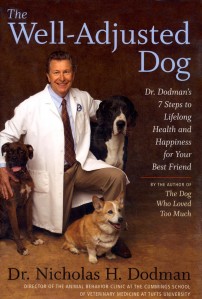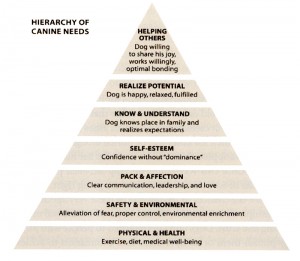Best, Short Dog Book Ever – Nicholas Dodman’s “The Well-Adjusted Dog”
March 17, 2009
 Dr. Nicholas Dodman, Director of the Animal Behavior Clinic at the Cumming School of Veterinary Medicine at Tufts University has produced a small gem of a book, The Well-Adjusted Dog.
Dr. Nicholas Dodman, Director of the Animal Behavior Clinic at the Cumming School of Veterinary Medicine at Tufts University has produced a small gem of a book, The Well-Adjusted Dog.
There’s more good, solid information in its 250 pages than in a whole host of other books written by dog ‘experts’ who have little or no credentials in the science and study of canines (Cesar Milan, I’m looking at you).
“Your job as a dog owner,” Dodman writes “is to try and understand your dog’s life fro his point of view, and to lead and protect, not to dominate, punish, and force a dog into submission, as popularized on too many of today’s TV shows.”
When this book comes out in paperback, I can see giving out multiple copies to neighbors and fellow dog owners, rather than trying to answer their questions myself.
One of the first and most vital points he makes is his belief that most dogs are under-exercised and bored out of their minds. (From my own experience I think this analysis is on the money). This leads to a multitude of behavioral problems including barking, inappropriate chewing, aggression, tail chasing, licking to the point of skin damage and more.
The average dog needs a minimum 30 minutes of aerobic exercise a day, every day. How many dogs do you know that meet that requirement?
Given that behavioral problems are the primary reason dogs are surrendered to shelters (the majority of whom are fated for euthanasia/destruction) proper handling of these issues may be essential to save the life of someone’s pet.
What I especially appreciate is his easy prose style and the clarity of his thinking even in controversial areas like herbal treatments and nutraceuticals. Here’s a sample of his writing about alternative medicine for dogs:
“Homeopathy—wherefore art thou, homeopathy? Though it’s popular in Europe, I have serious concerns about this branch of alternative medicine. The theory, of course, is that a little does of what ails you does you good. I can see how the concept applies to vaccination and desensitization to allergens, because inoculates stimulate an immune response—but I can’t see how it applies in other situations. Various homeopathic behavioral remedies containing microscopic concentrations of herbal products are now on the market.”
“One such remedy — anti-anxiety drops— was originally developed by an Irish veterinary practitioner who whipped up a dilute concoction of herbs to treat mastitis (inflammation of the udder) in cows. Being a large-animal vet, cows and mastitis were dear to his heart. In a moment of brilliance, he decided to bottle the cattle remedy for use in dogs to treat what else but . . .anxiety. And thus anti-anxiety drops were created. Whether the product actually works is doubtful, but bottles of the stuff are flying off the shelves. Naturopaths are positively swarming for it. Testing of this product presumably went like this:
- Take a worried-looking, baking dog and film him.
- Put the anxiety drops on his tongue.
- Wait until he has calmed down.
- Film him again.
- He’s calm.
- It’s a miracle!
The point they seemed to miss is that the only mental state that can follow a disturbed one is calm. It’s just a matter of time. I sent a sample of the anti-anxiety drops to the Department of Biochemistry and Experimental Therapeutics at Tufts medical school to see whether I ws missing something about the ingredients. The reply came back, ‘Nick, there’s virtually nothing here. It’s water.’ I guess that’s the point.”
Dodman also has constructed a pyramid Hierarchy of Canine Needs (adapted from psychologist Abraham Maslow’s triangle of human needs) that neatly summarizes what you as a caring dog owner should be striving towards. See how close you are coming to these goals with your own dog. Click image for larger size.
The bottom line: Buy This Book!
Leather Leashes vs. All Others – Part 1
March 27, 2008
I’ve always found that a six foot leather leash — nothing fancy, but something well made with brass fixings and reinforced stitching — is my favorite, as many times as I’ve used other leashes.
I never thought I would be one of those dog owners with an extendo-leash, the kind that has a hard rubber or plastic shell with a hand grip and a tough woven fabric 16 foot leash like the Flexi Soft Grip Comfort 1 retractable Cord Leash.
I’d see other people using them, or misusing them, barely keeping their dogs under control, and I formed a prejudice against ’em. These people were not ‘managing their dogs.”
It’s a line that has been drilled into my head by my favorite dog trainer, “Manage your dog.” I’m responsible for my dog’s safety and well-being. I should teach her good, polite behaviors and enforce them whenever we are outside or when company arrives. Any failure, any slice of wanton household destruction, any breach of protocol that puts my dog in jeopardy IS MY FAULT because I’m not properly Managing my Dog.
We recently added a new pooch to our permanent pack, Luna, a black female American style Labrador. Huxley, our chocolate Lab will be 6 this year. Our best guess about Luna is that she’s somewhere between 18 months and 2 years. After several months it became clear that her presence was having some effects on Huxley.
There were two noticeable behaviors: he began drinking exclusively from ‘her’ water bowl. And when we made the trip from out side door to our back yard – essentially the width of our one-car garage — he began asserting his independence by wandering down the drive way to pee over by our over-sized Christmas tree.
Next he’d saunter over to our 90 year old neighbor’s house across the street, position himself in the middle of her front lawn, squat and take a huge dump for all the passersby to see. He loves our neighbor Peg and she loves him and he wanted the world to know he was leaving her a brown token of his affection. Worse yet was when he’d lope across Prospect Drive and obliviously put himself in the path of mini-vans & SUVs.
There could not be a more public demonstration of my failure to Manage My Dog. And Huxley, is, by general consensus, a well-trained, polite canine. My analysis: He knows his behavior is transgressive and he persists because I believe it is status-related. She has to go right into the back yard to do her business while I, being senior, have more freedom than her! This independence is a part of Huxley’s character, he’s not your velcro-dog type at all.
But when this recently led to Huxley nearly getting hit by a van, I was totally freaked out, heart pounding, breath coming in short hyperventilating bursts — and resolved to get back to leashing him AT ALL TIMES!
Fortunately, the circumstances were all in our favor that morning. It was broad daylight, I was a few feet behind Huxley with a leash and a treat, yelling his name. The driver clearly saw both of us and slowed to a stop as I rushed passed, yelled jumbled apologies and gratitude over my shoulder, and continued after Huxley.
I was clearly Not Managing My Dog. I was failing spectacularly to Manage My Dog, in fact. This was my well-trained, polite Labrador? The one who never before was adamant about refusing to take that short walk across our drive way in the back yard, the fenced and secure and happy back yard? This starts happening when it becomes clear that Luna is here to stay and not another one of our many foster dogs; clearly her presence must be the triggering factor? Robert Park, author of the terrific Voodoo Science would say my belief engine is going into over drive here.
***
Disclaimer: I cringe when people anthropomorphize their dogs, but find that it is an impossibility for me to to completely avoid. All such statements should be understood in this context. It helps me to parse my beast’s behavior in terms that I can understand.
This interpretation is my own invention and may or may not correspond with the internal analytics going on in my dog’s brain. That it’s useful for me does not equate with its accuracy for representing Huxley’s thinking. I do think Huxley is thinking. I’m convinced of it.
I’m equally convinced that our mental syntax is so different, canine to primate, that all my interpretations of his internal mental states should be offered only as heavily qualified guesses.
***
But we talking about leather leashes and extendo-leashes, weren’t we? We now own two extendo-leashes and I’ve learned how to operate them without slicing off my own (or anyone else’s) fingers and extremities or causing blindness to anyone. Yet. These are some of the actual cautions from the packaging. Seriously, you wouldn’t want to be on the receiving end if your dog’s collar came loose and the ribbon and metal clasp were speeding rapidly back to you.
They do certainly give your dog more freedom to explore further away from you. But you have to pay attention and anticipate when you want to draw your dog nearer because she is always more than an arm’s length away. These extendo-leashes can be used properly, even if many people operate them at the far end of the safety spectrum.
But for control and all around functionality give me the dead animal skin every time.
More to Come

